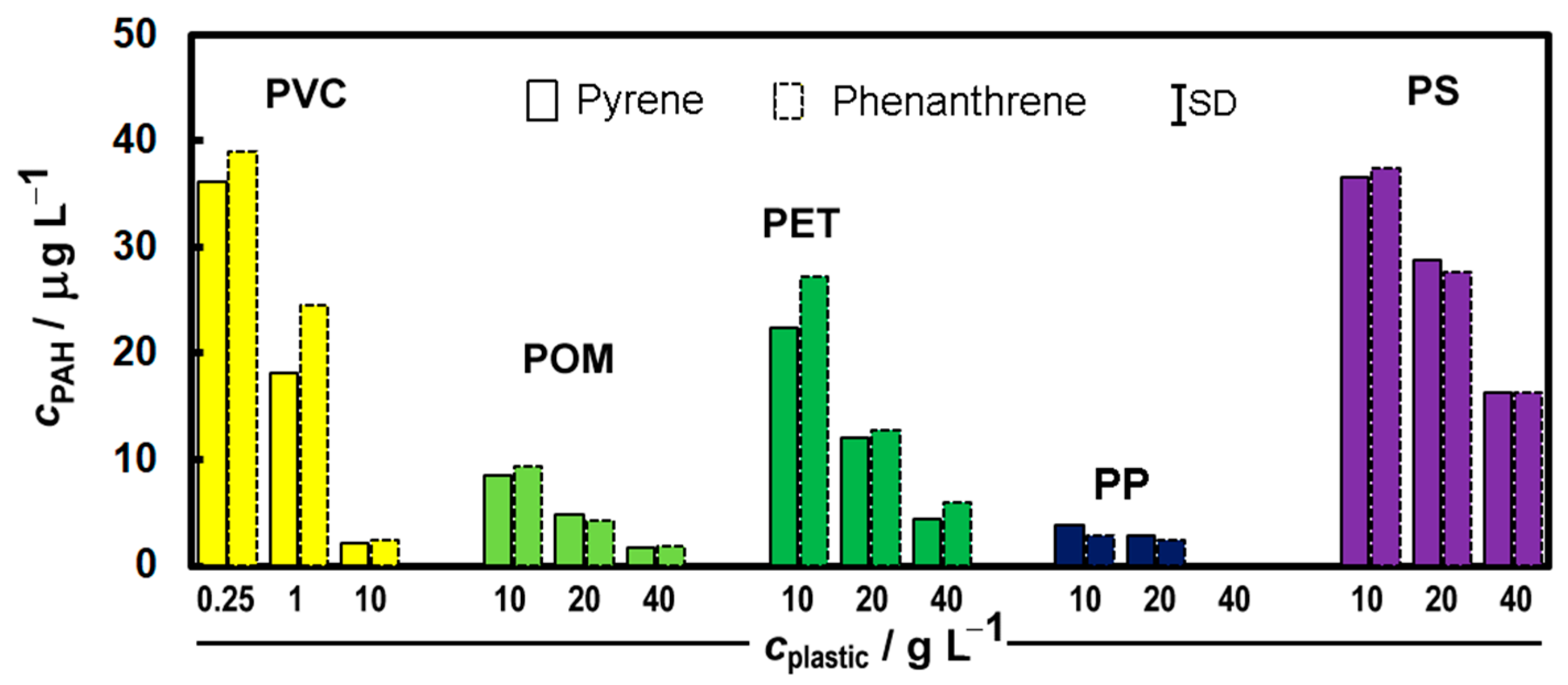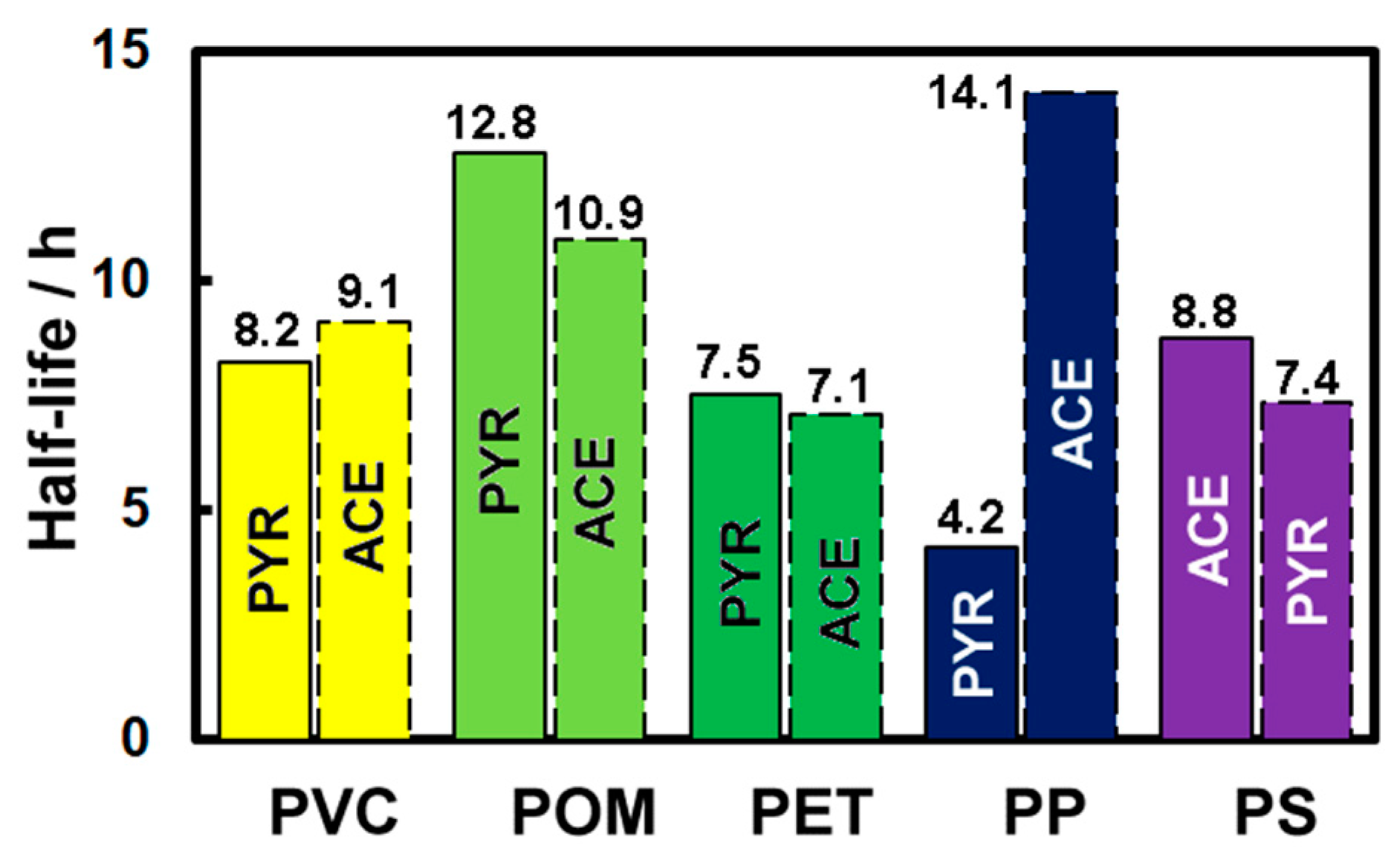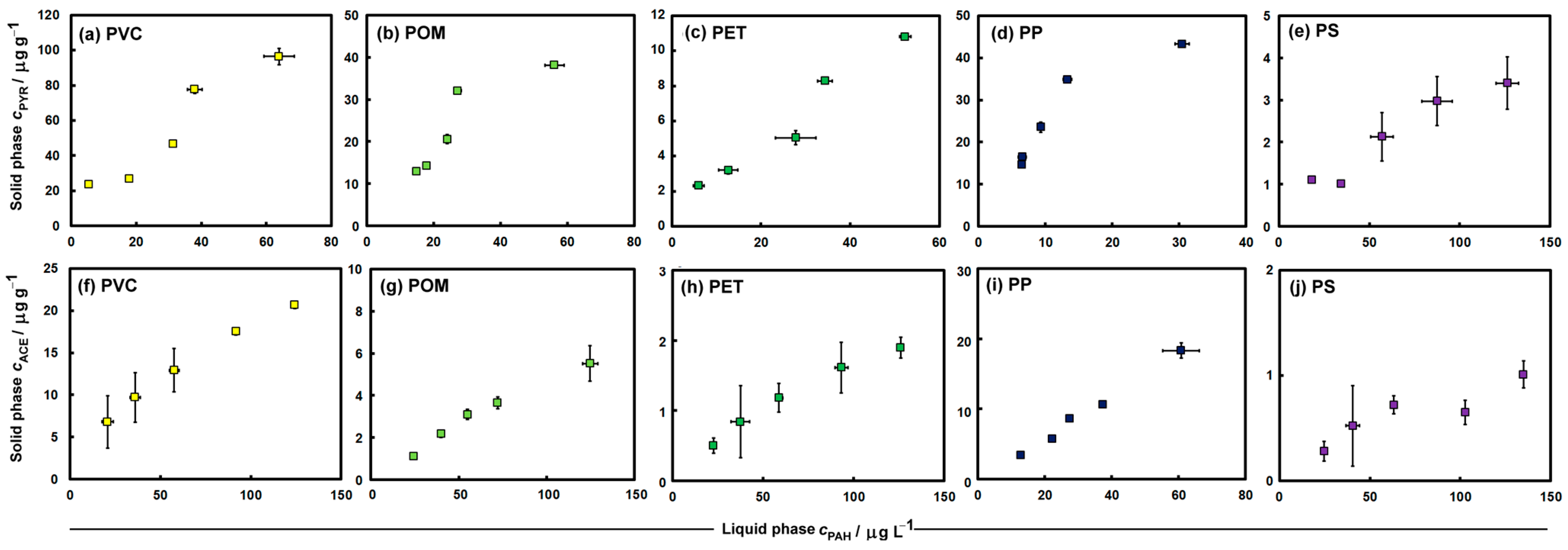Laboratory Measurements of Pyrene and Acenaphthene Partition into Microplastics
Abstract
1. Introduction
2. Materials and Methods
2.1. Materials
- Pyrene (PYR: C16H10) was purchased from Sigma-Aldrich and is a polycyclic aromatic hydrocarbon (PAH) consisting of four fused benzene rings, resulting in a flat aromatic system. Boiling point 394 °C. Solubility in water 0.049 mg L−1 (0 °C), 0.139 mg L−1 (25 °C), and 2.31 mg L−1 (75 °C) [41]. The logarithm of the partition coefficient (n-octanol/water) is 4.88.
- Acenaphthene (ACE: C12H10) is a polycyclic aromatic hydrocarbon (PAH) consisting of naphthalene with an ethylene bridge connecting positions 1 and 8. Solubility in water is 4 mg L−1, and vapour pressure is 5 mmHg at 115 °C. It was purchased from Supelco. The logarithm of the partition coefficient (n-octanol/water) is 3.92.
- Phenanthrene (PHE: C14H10) was purchased from Sigma-Aldrich (St. Louis, MO, USA) and is a polycyclic aromatic hydrocarbon (PAH) consisting of three angled fused rings. Solubility in water is 1.6 mg L−1, and the logarithm of the partition coefficient (n-octanol/water) is 4.46.
2.2. Experimental Method
2.3. Data Analysis
3. Results
3.1. Setting Concentrations
3.2. Uptake onto Pellets
3.3. Kinetics
3.4. Estimating Kd
4. Discussion
5. Conclusions
Author Contributions
Funding
Institutional Review Board Statement
Informed Consent Statement
Data Availability Statement
Conflicts of Interest
References
- Guzzetti, E.; Sureda, A.; Tejada, S.; Faggio, C. Microplastic in marine organism: Environmental and toxicological effects. Environ. Toxicol. Pharmacol. 2018, 64, 164–171. [Google Scholar] [CrossRef]
- Nobre, C.R.; Santana, M.F.; Maluf, A.; Cortez, F.S.; Cesar, A.; Pereira, C.D.; Turra, A. Assessment of microplastic toxicity to embryonic development of the sea urchin Lytechinus variegatus (Echinodermata: Echinoidea). Mar. Pollut. Bull. 2015, 92, 99–104. [Google Scholar] [CrossRef]
- Wright, S.L.; Thompson, R.C.; Galloway, T.S. The physical impacts of microplastics on marine organisms: A review. Environ. Pollut. 2013, 178, 483–492. [Google Scholar] [CrossRef]
- Koelmans, A.A.; Bakir, A.; Burton, G.A.; Janssen, C.R. Microplastic as a vector for chemicals in the aquatic environment: Critical review and model-supported reinterpretation of empirical studies. Environ. Sci. Technol. 2016, 50, 3315–3326. [Google Scholar] [CrossRef]
- Venrick, E.L.; Backman, T.W.; Bartram, W.C.; Platt, C.J.; Thornhill, M.S.; Yates, R.E. Man-made objects on the surface of the central North Pacific Ocean. Nature 1973, 241, 271. [Google Scholar] [CrossRef]
- Harris, P.T. The fate of microplastic in marine sedimentary environments: A review and synthesis. Mar. Pollut. Bull. 2020, 158, 111398. [Google Scholar] [CrossRef] [PubMed]
- Lo, H.S.; Xu, X.; Wong, C.Y.; Cheung, S.G. Comparisons of microplastic pollution between mudflats and sandy beaches in Hong Kong. Environ. Pollut. 2018, 236, 208–217. [Google Scholar] [CrossRef]
- Ritchie, H.; Samborska, V.; Roser, M. Plastic Pollution. Our World in Data. 2018. Available online: https://ourworldindata.org/plastic-pollution? (accessed on 29 December 2023).
- PlasticsEurope. An Analysis of European Plastics Production, Demand and Waste Data. Plastics—The Facts; PlasticsEurope: Brussels, Belgium, 2020. [Google Scholar]
- Geyer, R.; Jambeck, J.R.; Law, K.L. Production, use, and fate of all plastics ever made. Sci. Adv. 2017, 3, e1700782. [Google Scholar] [CrossRef]
- Barnes, D.K.; Galgani, F.; Thompson, R.C.; Barlaz, M. Accumulation and fragmentation of plastic debris in global environments. Philos. Trans. R. Soc. B Biol. Sci. 2009, 364, 1985–1998. [Google Scholar] [CrossRef]
- Tang, C.C.; Chen, Y.T.; Zhang, Y.M.; Chen, H.I.; Brimblecombe, P.; Lee, C.L. Cracking and photo-oxidation of polyoxymethylene degraded in terrestrial and simulated marine environments. Front. Mar. Sci. 2022, 9, 843295. [Google Scholar] [CrossRef]
- Besseling, E.; Quik, J.T.; Sun, M.; Koelmans, A.A. Fate of nano-and microplastic in freshwater systems: A modeling study. Environ. Pollut. 2017, 220, 540–548. [Google Scholar] [CrossRef]
- Connors, E.J. Distribution and biological implications of plastic pollution on the fringing reef of Mo’orea, French Polynesia. PeerJ 2017, 5, e3733. [Google Scholar] [CrossRef]
- Kühn, S.; van Franeker, J.A.; O’Donoghue, A.M.; Swiers, A.; Starkenburg, M.; van Werven, B.; Foekema, E.; Hermsen, E.; Egelkraut-Holtus, M.; Lindeboom, H. Details of plastic ingestion and fibre contamination in North Sea fishes. Environ. Pollut. 2020, 257, 113569. [Google Scholar] [CrossRef]
- Rist, S.; Baun, A.; Hartmann, N.B. Ingestion of micro-and nanoplastics in Daphnia magna–Quantification of body burdens and assessment of feeding rates and reproduction. Environ. Pollut. 2017, 228, 398–407. [Google Scholar] [CrossRef]
- Chatterjee, S.; Sharma, S. Microplastics in our oceans and marine health. Field Actions Science Reports. J. Field Actions 2019, 19, 54–61. [Google Scholar]
- Turner, A. Mobilisation kinetics of hazardous elements in marine plastics subject to an avian physiologically-based extraction test. Environ. Pollut. 2018, 236, 1020–1026. [Google Scholar] [CrossRef]
- Mai, L.; He, H.; Bao, L.J.; Liu, L.Y.; Zeng, E.Y. Plastics are an insignificant carrier of riverine organic pollutants to the coastal oceans. Environ. Sci. Technol. 2020, 54, 15852–15860. [Google Scholar] [CrossRef] [PubMed]
- Turner, A.; Holmes, L.A. Adsorption of trace metals by microplastic pellets in fresh water. Environ. Chem. 2015, 12, 600–610. [Google Scholar] [CrossRef]
- Wang, L.C.; Chun-Te Lin, J.; Dong, C.D.; Chen, C.W.; Liu, T.K. The sorption of persistent organic pollutants in microplastics from the coastal environment. J. Hazard. Mater. 2021, 420, 126658. [Google Scholar] [CrossRef]
- Stollberg, N.; Kröger, S.D.; Reininghaus, M.; Forberger, J.; Witt, G.; Brenner, M. Uptake and absorption of fluoranthene from spiked microplastics into the digestive gland tissues of blue mussels, Mytilus edulis L. Chemosphere 2021, 279, 130480. [Google Scholar] [CrossRef]
- Wang, L.; Hou, D. Plastistone: An emerging type of sedimentary rock. Earth-Sci. Rev. 2023, 104620. [Google Scholar] [CrossRef]
- Ho, Y.S.; McKay, G. Pseudo-second order model for sorption processes. Process Biochem. 1999, 34, 451–465. [Google Scholar] [CrossRef]
- Khamizov, R.K. A pseudo-second order kinetic equation for sorption processes. Russ. J. Phys. Chem. A 2020, 94, 171–176. [Google Scholar] [CrossRef]
- O’Connor, I.A.; Golsteijn, L.; Hendriks, A.J. Review of the partitioning of chemicals into different plastics: Consequences for the risk assessment of marine plastic debris. Mar. Pollut. Bull. 2016, 113, 17–24. [Google Scholar] [CrossRef]
- Liu, L.; Fokkink, R.; Koelmans, A.A. Sorption of polycyclic aromatic hydrocarbons to polystyrene nanoplastic. Environ. Toxicol. Chem. 2016, 35, 1650–1655. [Google Scholar] [CrossRef]
- Fu, L.; Li, J.; Wang, G.; Luan, Y.; Dai, W. Adsorption behavior of organic pollutants on microplastics. Ecotoxicol. Environ. Saf. 2021, 217, 112207. [Google Scholar] [CrossRef]
- Chen, Z.; Yang, J.; Huang, D.; Wang, S.; Jiang, K.; Sun, W.; Chen, Z.; Cao, Z.; Ren, Y.; Wang, Q.; et al. Adsorption behavior of aniline pollutant on polystyrene microplastics. Chemosphere 2023, 323, 138187. [Google Scholar] [CrossRef]
- Rochman, C.M.; Hoh, E.; Hentschel, B.T.; Kaye, S. Long-term field measurement of sorption of organic contaminants to five types of plastic pellets: Implications for plastic marine debris. Environ. Sci. Technol. 2013, 47, 1646–1654. [Google Scholar] [CrossRef]
- Rochman, C.M.; Manzano, C.; Hentschel, B.T.; Simonich, S.L.; Hoh, E. Polystyrene plastic: A source and sink for polycyclic aromatic hydrocarbons in the marine environment. Environ. Sci. Technol. 2013, 47, 13976–13984. [Google Scholar] [CrossRef]
- Hüffer, T.; Hofmann, T. Sorption of non-polar organic compounds by micro-sized plastic particles in aqueous solution. Environ. Pollut. 2016, 214, 194–201. [Google Scholar] [CrossRef]
- Karapanagioti, H.K.; Klontza, I. Testing phenanthrene distribution properties of virgin plastic pellets and plastic eroded pellets found on Lesvos island beaches (Greece). Mar. Environ. Res. 2008, 65, 283–290. [Google Scholar] [CrossRef]
- Wu, J.; Xu, P.; Chen, Q.; Ma, D.; Ge, W.; Jiang, T.; Chai, C. Effects of polymer aging on sorption of 2, 2′, 4, 4′-tetrabromodiphenyl ether by polystyrene microplastics. Chemosphere 2020, 253, 126706. [Google Scholar] [CrossRef]
- Dmitrienko, S.G.; Gurariy, E.Y.; Nosov, R.E.; Zolotoz, Y.A. Solid-phase extraction of polycyclic aromatic hydrocarbons from aqueous samples using polyurethane foams in connection with solidmatrixs spectrofluorimetry. Anal. Lett. 2001, 34, 425–438. [Google Scholar] [CrossRef]
- Lohmann, R. Critical review of low-density polyethylene’s partitioning and diffusion coefficients for trace organic contaminants and implications for its use as a passive sampler. Environ. Sci. Technol. 2012, 46, 606–618. [Google Scholar] [CrossRef]
- Guo, X.; Chen, C.; Wang, J. Sorption of sulfamethoxazole onto six types of microplastics. Chemosphere 2019, 228, 300–308. [Google Scholar] [CrossRef]
- Lohmann, R.; Klanova, J.; Pribylova, P.; Liskova, H.; Yonis, S.; Bollinger, K. PAHs on a west-to-east transect across the tropical Atlantic Ocean. Environ. Sci. Technol. 2013, 47, 2570–2578. [Google Scholar] [CrossRef]
- Lu, J.; Zhang, C.; Wu, J.; Lin, Y.; Zhang, Y.; Yu, X.; Zhang, Z. Pollution, sources, and ecological-health risks of polycyclic aromatic hydrocarbons in coastal waters along coastline of China. Hum. Ecol. Risk Assess. Int. J. 2020, 26, 968–985. [Google Scholar] [CrossRef]
- Falahudin, D.; Munawir, K.; Arifin, Z.; Wagey, G.A. Distribution and sources of polycyclic aromatic hydrocarbons (PAHs) in coastal waters of the Timor Sea. Coast. Mar. Sci. 2012, 35, 112–121. [Google Scholar]
- Haynes, W.M. CRC Handbook of Chemistry and Physics, 97th ed.; CRC Press: Boca Raton, FL, USA, 2016; ISBN 9781498754293. [Google Scholar]
- Ma, J.; Zhao, J.; Zhu, Z.; Li, L.; Yu, F. Effect of microplastic size on the adsorption behavior and mechanism of triclosan on polyvinyl chloride. Environ. Pollut. 2019, 254, 113104. [Google Scholar] [CrossRef]
- Wang, W.; Wang, J. Comparative evaluation of sorption kinetics and isotherms of pyrene onto microplastics. Chemosphere 2018, 193, 567–573. [Google Scholar] [CrossRef]
- Yang, C.; Wu, W.; Zhou, X.; Hao, Q.; Li, T.; Liu, Y. Comparing the sorption of pyrene and its derivatives onto polystyrene microplastics: Insights from experimental and computational studies. Mar. Pollut. Bull. 2021, 173, 113086. [Google Scholar] [CrossRef]
- Agboola, O.D.; Benson, N.U. Physisorption and chemisorption mechanisms influencing micro (nano) plastics-organic chemical contaminants interactions: A review. Front. Environ. Sci. 2021, 9, 167. [Google Scholar] [CrossRef]
- Teuten, E.L.; Rowland, S.J.; Galloway, T.S.; Thompson, R.C. Potential for plastics to transport hydrophobic contaminants. Environ. Sci. Technol. 2007, 41, 7759–7764. [Google Scholar] [CrossRef] [PubMed]
- Li, J.; Zhang, K.; Zhang, H. Adsorption of antibiotics on microplastics. Environ. Pollut. 2018, 237, 460–467. [Google Scholar] [CrossRef] [PubMed]





| Property | PVC | POM | PET | PP | PS |
|---|---|---|---|---|---|
| Density a/g cm−3 | 1.391 | 1.41 | 1.68 | 0.9 | 1.05 |
| Melting point a/°C | 212 | 165 | 250–255 | 157 | 240 |
| Crystallinity b | Amph | Cryst | SC | SC | Amph |
| Water content b/mass % | 0.04–0.40 | 0.11–0.50 | 0.10–0.30 | 0.01–0.02 | 0.01–0.04 |
| Global production 2018–2022/Tg a−1 | 44 | 1.4 | 56 | 56 | 4 |
| Experimental conditions | |||||
| Plastic in solution/g L−1 | 1 | 5 | 10 | 5 | 10 |
| Pellet diameter/mm | 0.1 | 3 | 4 | 5 | 5 |
| Plastic | kPYR/10−6 s−1 | kACE/10−6 s−1 |
|---|---|---|
| PVC | 23.44 ± 0.06 | 21.11 ± 0.07 |
| POM | 15.06 ± 0.005 | 17.62 ± 0.13 |
| PET | 25.55 ± 0.014 | 27.20 ± 0.31 |
| PP | 45.59 ± 0.25 | 13.65 ± 0.01 |
| PS | 21.98 ± 0.01 | 26.11 ± 0.04 |
| Plastic | DPYR | DACE | DPHE | Method |
|---|---|---|---|---|
| PVC | 1.35 ± 0.18 | 0.13 ± 0.001 | isotherm | |
| 1.71 ± 0.17 | 0.41 ± 0.07 | kinetic | ||
| 1.83 ± 0.35 | 1.36 ± 0.48 | partition | ||
| POM | 0.6 ± 0.008 | 0.016 ± 0.0001 | isotherm | |
| 0.96 ± 0.03 | 0.11 ± 0.02 | kinetic | ||
| 0.55 ± 0.12 | 0.53 ± 0.08 | partition | ||
| PET | 0.19 ± 0.0002 | 0.013 ± 0.0001 | isotherm | |
| 0.24 ± 0.006 | 0.036 ± 0.008 | kinetic | ||
| 0.18 ± 0.07 | 0.14 ± 0.05 | partition | ||
| PP | 1.11 ± 0.02 | 0.31 ± 0.0003 | isotherm | |
| 3.00 ± 0.30 | 0.44 ± 0.07 | kinetic | ||
| 1.02 ± 0.27 | 1.33 ± 0.5 | partition | ||
| PS | 0.025 ± 0.0001 | 0.005 ± 0.0001 | isotherm | |
| 0.04 ± 0.01 | 0.04 ± 0.01 | kinetic | ||
| 0.04 ± 0.01 | 0.04 ± 0.01 | partition |
Disclaimer/Publisher’s Note: The statements, opinions and data contained in all publications are solely those of the individual author(s) and contributor(s) and not of MDPI and/or the editor(s). MDPI and/or the editor(s) disclaim responsibility for any injury to people or property resulting from any ideas, methods, instructions or products referred to in the content. |
© 2024 by the authors. Licensee MDPI, Basel, Switzerland. This article is an open access article distributed under the terms and conditions of the Creative Commons Attribution (CC BY) license (https://creativecommons.org/licenses/by/4.0/).
Share and Cite
Zhang, Y.-M.; Brimblecombe, P.; Lee, C.-L. Laboratory Measurements of Pyrene and Acenaphthene Partition into Microplastics. J. Mar. Sci. Eng. 2024, 12, 337. https://doi.org/10.3390/jmse12020337
Zhang Y-M, Brimblecombe P, Lee C-L. Laboratory Measurements of Pyrene and Acenaphthene Partition into Microplastics. Journal of Marine Science and Engineering. 2024; 12(2):337. https://doi.org/10.3390/jmse12020337
Chicago/Turabian StyleZhang, Yi-Ming, Peter Brimblecombe, and Chon-Lin Lee. 2024. "Laboratory Measurements of Pyrene and Acenaphthene Partition into Microplastics" Journal of Marine Science and Engineering 12, no. 2: 337. https://doi.org/10.3390/jmse12020337
APA StyleZhang, Y.-M., Brimblecombe, P., & Lee, C.-L. (2024). Laboratory Measurements of Pyrene and Acenaphthene Partition into Microplastics. Journal of Marine Science and Engineering, 12(2), 337. https://doi.org/10.3390/jmse12020337







